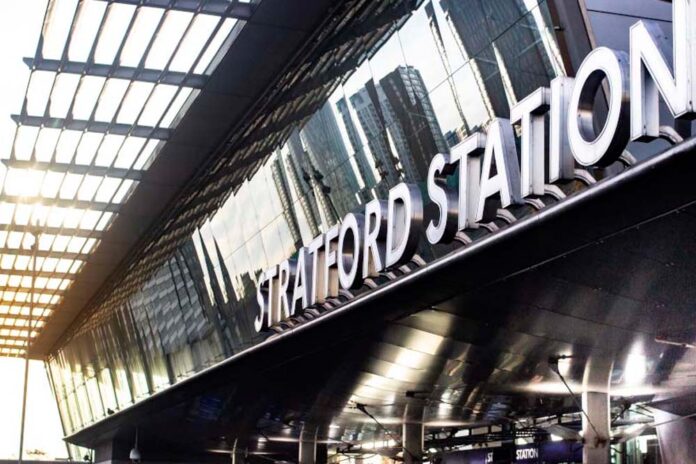London’s Stratford station was the top stop for passengers during the pandemic.
The station, the Office of Rail and Road says, had the most people entering and exiting the station during the 2020-2021 period, a time when station usage dropped by 78% year-on-year. The statistics cover more than 2,500 stations.
The impact of the pandemic meant rail saw its lowest number of journeys since 1872; London station saw the biggest decrease in passenger station usage, with 12.2 million entries and exits compared to the 86.9 million in 2019-20.
Stratford climbed to the top after having 13,985,162 entries and exits over 2020-2021. This also marks the first time for 17 years London Waterloo did not take the top position.
London’s railway stations dominate the top ten most used, with London Victoria also heavily visited during the pandemic, with 13.8 million entries and exits, followed by London Bridge also with 13.8 million. London Liverpool Street (11.2 million) also made the top five most-used stations in Britain.
Highbury and Islington (8.7m), Clapham Junction (8.4m), Barking (6.7m) and East Croydon (6.7m) made their way into the top 10 for the first time, replacing London Paddington, London Euston, London St Pancras International and London Kings Cross.
ORR’s figures also show Birmingham New Street as the only station outside of London that recorded more than 6 million entries and exits, with 7.4 million people travelling from or to the station in 2020-21.
Liverpool Lime Street (3.5m) and Cambridge (2.3m) were the only stations included in the top 10 most used stations outside of London that did not appear last year. These two stations replaced Gatwick Airport and Glasgow Queen Street.
Across Scotland, Glasgow Central remained the most used station with 5.3 million entries and exits, down from 32.5 million in 2019-20. Edinburgh (2.9m), Glasgow Queen Street (2.3m), Paisley Gilmour Street (982,530) and new entrant Partick (634,162) were also in the top 5 most used.
In Wales, Cardiff Central also remained the busiest station during 2020-21 but saw just under 2 million entries and exits compared to more than 12 million last year. Newport in South Wales (543,356), Cardiff Queen Street (472,914), Swansea (468,824) and Bridgend (321,576) completed the top 5 most used.
And only five railway stations in Great Britain had more than 10 million entries and exits in 2020-21 compared with 43 stations in 2019-20.
Nearly 200 railway stations across Britain had fewer than 1,000 entries and exits, with six recording no entries or exits during the last year as a result of services temporarily suspended at the majority of these stations due to the pandemic.
There were 18 stations with less than 20 and 59 with less than 100 recorded entries in 2020-21.
This is not without a (somewhat small) silver lining: last year’s least used station was Berney Arms (Norfolk, England) with 42 entries and exits. In 2020-21, the number of entries and exits at this station increased to 348, which was the biggest percentage increase of any station compared with the previous year.
Feras Alshaker, director of planning and performance at the Office of Rail and Road said: “Throughout 2020-21 the railways remained an essential service for those people who needed to travel during a year which was impacted by the pandemic.
“We’ve seen a radical change, especially in London, in the stations people were using the most. Stratford, Highbury and Islington, Clapham Junction, Barking and East Croydon replaced Kings Cross, St. Pancras, Euston and Paddington in the top ten, underlining their importance as vital stops and interchanges, linking key workers with underground and bus services to travel.
“This year we have seen many railway stations with very few passenger entries and exits. However, we know that recent figures show leisure journeys are nearly back to pre-pandemic levels, while there has been a slower increase in commuter journeys.”
Andy Bagnall, director general at the Rail Delivery Group, said: “The station usage figures show how the rail industry kept people moving for the first year of the pandemic. Some of the entries on the list reflect where people like key workers were travelling from and also the acceleration of changes to how people are travelling after the pandemic.
“Rail companies are working together to welcome people back and the recent increase in passengers continues to both reflect and support the nation’s recovery. We know that taking the train is much more than a journey as passengers contributed some £133 billion to the economy before the pandemic by spending in places such as shops, restaurants and hotels.”







































 0113 2082620
0113 2082620 info@railbusinessdaily.com
info@railbusinessdaily.com 15 Mariner Court, Wakefield WF4 3FL
15 Mariner Court, Wakefield WF4 3FL

